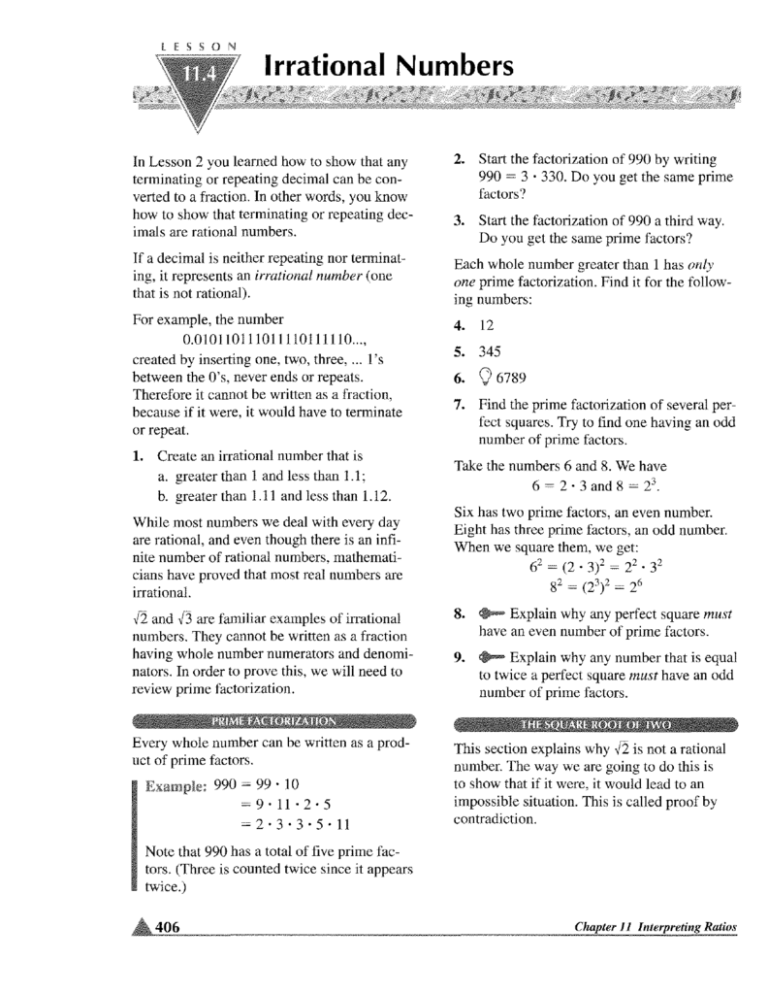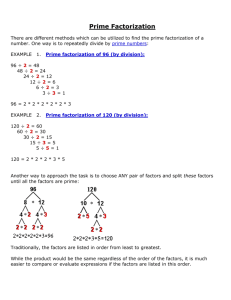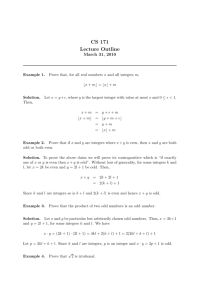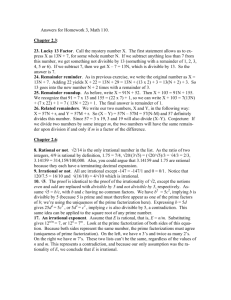Irrational Numbers - Math Education Page
advertisement

lESSON
Irrational Numbers
In Lesson 2 you learned how to show that any
terminating or repeating decimal can be converted to a fraction. In other words, you know
how to show that terminating or repeating decimals are rational numbers.
2.
Start the factorization of 990 by writing
990 = 3 · 330. Do you get the same prime
factors?
3.
Start the factorization of 990 a third way.
Do you get the same prime factors?
If a decimal is neither repeating nor terminating, it represents an irrational number (one
that is not rational).
Each whole number greater than 1 has only
one prime factorization. Find it for the following numbers:
For example, the number
O.OlOl!OlllOllllOlllllO ... ,
created by inserting one, two, three, ... l 's
between the O's, never ends or repeats.
Therefore it cannot be written as a fraction,
because if it were, it would have to terminate
or repeat.
4.
12
5.
345
1.
Create an irrational number that is
a. greater than l and less than 1.1;
b. greater than 1.11 and Jess than 1.12.
While most numbers we deal with every day
are rational, and even though there is an infinite number of rational numbers, mathematicians have proved that most real numbers are
irrational.
6.
7.
v
6789
Find the prime factorization of several perfect squares. Try to find one having an odd
number of prime factors.
Take the numbers 6 and 8. We have
6 = 2 · 3 and 8 = 2 3
Six has two prime factors, an even number.
Eight has three prime factors, an odd number.
When we square them, we get:
62 = (2 . 3) 2 = 22 • 32
82
= (23)2 = 26
{2 and [.3 are familiar examples of irrational
numbers. They cannot be written as a fraction
having whole number numerators and denominators. In order to prove this, we will need to
review prime factorization.
8. . _ Explain why any perfect square must
have an even number of prime factors.
Every whole number can be written as a product of prime factors.
This section explains why {2 is not a rational
number. The way we are going to do this is
to show that if it were, it would lead to an
impossible situation. This is called proof by
contradiction.
lAhiaUIJ~''-'• 990 = 99 • j 0
=9·11·2·5
=2·3·3·5·11
9. . _ Explain why any number that is equal
to twice a perfect square must have an odd
number of prime factors.
Note that 990 has a total of five prime factors. (Three is counted twice since it appears
twice.)
44o&
Chapter 11 Interpreting Ratios
If p and q were nonzero whole numbers and
we had
E=f2
q
It would follow that (~)' =
17. Does the line y = f2x pass through any
lattice points?
p'
= 2
q
2l
10. Explain each step in the previous
calculations.
11. Explain why p 2 must have an even number
of prime factors.
12. Explain why 2l must have an odd number
of prime factors.
13. Explain why p 2 cannot equal
15. ..,_. Show why the method does not work
to prove that {4 is irrational.
16. Does the decimal expansion of {2 terminate or repeat?
({2)'
2
p2 =
14. ..,_.Use the same method to show that {3
is irrational.
18. ..,_. Do all lines through the origin eventually pass through a lattice point?
Discuss.
19.1;ii#ii§l!in is probably the world's most
famous irrational number. Find out about
its history.
2l.
We conclude that there can be no whole numbers p and q such that {2 = p/q, and therefore
{2 is irrati on a!.
SUM FRACTIONS
20. Find two lowest-term fractions having
different denominators whose sum is 8/9.
11.4 Irrational Numbers
COMPARING COUPONS
21. Which is a better deal, 15% off the
purchase price, or $1 off every $5 spent?
Make a graph that shows how much you
save with each discount, for various purchases from $1 to $20. Write about your
conclusions.
4074







